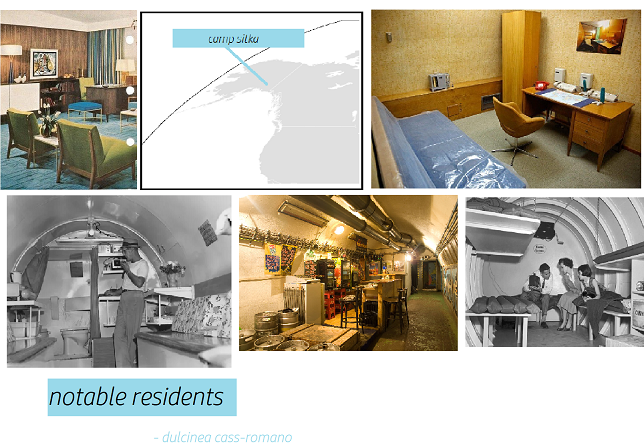Camp Sitka
The mainly American and Russian inhabitants of Camp Sitka defected to a quiet underground network of bunkers in 2075, at the start of the War. By and large, these residents are politically leftist but unwilling to face the threat of execution that comes with supporting the CAMaN publicly in their home nations.
Camp Sitka consists of approximately forty-two bunkers in a four-mile stretch in an nonspecific location southwest Alaska. They are arranged linearly, and all can be accessed through an external hallway-sized underground tunnel. Residents communicate through two sets of radios between them, with a transfer station in the middle repeating messages from one line onto another.
There are an average of four residents per bunker. Food is harvested in two large, artificially lit greenhouses connected to the west and east sides of the Camp.
Demographics
Bunker dynamics can be broken down as per the following trends:
- 6 bunkers - Nuclear Families (1-3 adults, 2-3 children) - parent(s) and progeny, with sometimes an additional family member such as grandparent or nibling
- 13 bunkers - Non-Nuclear Families (1-6 adults, 0-5 children) - people who are related, but can be any combination of parents, children, niblings, piblings, grandparents, cousins, etc.
- 18 bunkers - Voluntary Roommates (3-5 adults) - groups of nonrelated people who had a previous platonic, romantic, or business relationship and chose to bunk together in the camp.
- 5 bunkers - Nonvoluntary Roommates (3-4 adults or 3-4 children) - groups of nonrelated people who had no previous platonic, romantic, or business relationship and did not choose to bunk together in the camp. Discounts for single inhabitants in Camp Sitka proved popular with parents who wanted to ensure the survival of their children, or other dynamics that could not afford to reserve an entire bunker.
Infrastructure
Forty-two residential bunkers connected by an underground, external hallway.
Four public bathrooms (three toilets, two shower stalls) spread out across the hallway.
500 sq. foot Common area in center with television, bookshelves, and DVDs.
500 sq. foot kitchen, food storage, and cafeteria complex.
Two multi-level greenhouses on the east and west sides of the development.
External solar panels on tundra floor.
Water-collection mechanisms capture and filter snow melt and precipitation; the movement through this system creates hydroelectric power.
History
The purchase of one-room bunker included three meals a day for four residents and access to facilities. Once the Settlement Date was announced, the residents could start entering.
When they first went on the market in 2061, a bunker was $4,000, but skyrocketed amidst increasing global turmoil and risk of global nuclear fallout.
2061- $4,000 / bunker - three bunkers reserved
2062-2064- $4,500 / bunker - four bunkers reserved
2065- $6,775 / bunker - nine bunkers reserved
2066- $8,999 / bunker - twelve bunkers reserved
2067- $19,999 / bunker - fifteen bunkers reserved
2068- $30,000 / bunker - twenty-five bunkers reserved
2069-70- $49,000 / bunker - forty-two bunkers reserved - SOLD OUT
Camp Sitka opened for settlement in November 2074 until the final positions were filled in August 2075.
Geography
Located on the Alaskan tundra, which is, granted, less frigid than it was a century ago.
Type
Underground / Vault
Population
170
Inhabitant Demonym
Sitkars
Remove these ads. Join the Worldbuilders Guild









Comments